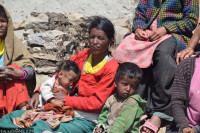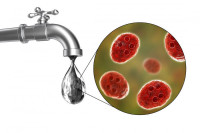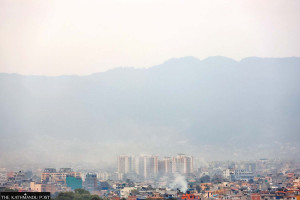Health
Health ministry to move to prefab office at Singha Durbar
World Health Organisation has provided six prefab units to house the ministry after its building was destroyed during September protests.Post Report
The Ministry of Health and Population is preparing to relocate inside Singha Durbar after the World Health Organisation handed over newly built prefabricated structures to the government.
Currently, the ministry has been operating from the Nepal Health Research Council building at Ramshahpath since its own building was destroyed during the Gen Z protest on September 9.
“We have started shifting furniture and other materials inside Singha Durbar,” said Dr Prakash Budathoky, spokesperson at the ministry. “From next week we will start working from Singha Durbar.”
The youth-led anti-corruption protests on September 9, sparked after the government used brutal force against demonstrators on September 8, completely destroyed the Health Ministry’s building along with crucial and sensitive documents, including bilateral agreements. Seventy-six people were killed in the nationwide protests.
The Health Ministry's building was designed by world-renowned American architect Louis I Kahn. International students used to visit the building to study its unique design.
The structure built in 1965 was originally constructed for the use of the Family Planning and Maternal Child Welfare programme. It featured two isometric brick blocks, deep vertical window recess and a roof top parapet with sky-framing apertures and is among few architectural jewels of the country.
The building endured the 1988 and 2015 mega earthquakes. Protesters during 1979, 1990 and 2005 did not target it.
The UN health body, which officially handed over newly constructed structures to the government on Thursday, said that the new facilities would facilitate resumption of critical health governance and administrative functions.
Speaking at the structure handover ceremony at Singha Durbar, Dr Catharina Boehme, officer-in-charge of the WHO South-East Asia Regional Office, highlighted the importance of strong partnerships and rapid recovery support. She said that the new structure will support the ministry to continue its vital work in health policy formulation, coordination and service delivery.
“This facility is far more than a physical structure — it is a symbol of resilience, preparedness, and partnership,” said Boehme. “It restores a functional home for essential health leadership and coordination, ensuring that critical operations can continue without interruption.”
Officials at the Health Ministry, who have been working in congested space at the council, said that even the prefab structure will not be sufficient for full-fledged operation of the ministry.
“The ministry has to run the entire health governance of the entire country,” said Dr Samir Adhikari, joint spokesperson at the ministry. “But something is better than nothing, so we will resume our work from inside Singha Durbar.”
Health officials have been using meeting halls of the Department of Health Services for meetings with delegates due to lack of space in the council’s building. Officials say they have often had to request foreign delegates and development partners to reduce their delegation size because of the congestion at the current office.




 13.12°C Kathmandu
13.12°C Kathmandu













